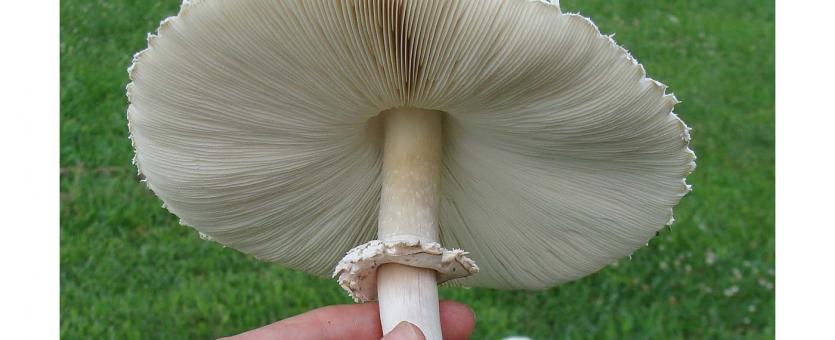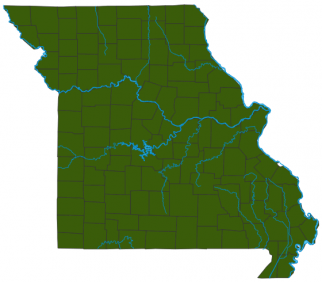
Large, white, with broad, cream-colored scales on cap, white gills turning gray-green, and a stalk ring. July–September. Cap round, becoming flat; white, with large whitish, pinkish, or cream-colored patches in center; patches breaking into many small scales when cap is open. Gills broad; spacing close; white, becoming gray-green or darker; attachment free. Stalk enlarges toward the base; white, darkens when handled; texture smooth; upper stalk has ring. Partial veil leaves a ring on the stalk resembling a napkin ring. Spore print green. Spores magnified: elliptical, smooth, with small pore at tip.
Lookalikes: Most true lepiotas have white spore prints. Reddening lepiota (Leucoagaricus americanus) bruises red. Parasol (Macrolepiota procera) has a tall, slender, scaly stalk. Agaricus species have brown spore prints. Thiers amanita (A. thiersii) has a white spore print. Shaggy mane (Coprinus comatus) has a cylindrical cap, turning inky with age, and black spores.
Cap width: 2–12 inches; stalk length: 3–10 inches; stalk width: ¼–1 inch.

Statewide.
Habitat and Conservation
This mushroom is found in summer and fall, on the ground in lawns, pastures and meadows. They often appear in “fairy rings,” emerging as a circle of mushrooms. The circle results from the growth pattern of the parent fungus, which lives in the soil. As it feeds, it depletes nutrients and expands outward, getting larger every year. Sometimes called the "green gill" to distinguish it from similar species, which have white or cream gills and spores.
Status
Poisonous. This very common mushroom is not deadly, but it can make you very sick. Although these mushrooms can be quite large and abundant, do not eat them. They can cause violent gastrointestinal upset, including vomiting and diarrhea severe enough to require hospitalization. Prevent your children and pets from eating them, too.
Life Cycle
Mushrooms exist most of the time underground or within rotting logs as a network of cells (mycelium) connected to tree roots, rotting material, and the soil. When ready to reproduce, the mycelium forms the aboveground mushroom; these are reproductive structures. Spores are produced in the gills and are released to begin new mycelia elsewhere. The mycelium of a mushroom can live for decades.
Human Connections
These large, attractive mushrooms often appear on lawns and are one of the most commonly eaten poisonous mushrooms. The immature “button” stage can look like the familiar grocery store mushroom. Never eat a wild mushroom unless you’re 100 percent sure of its identity.
Ecosystem Connections
Fungi are vitally important for a healthy ecosystem. Many form symbiotic relationships with roots of many trees, helping them to survive. Fungi also feed on decomposing materials, such as fallen leaves and logs, cleaning the forest and helping nutrients to cycle back into the soil.








Mushrooms are a lot like plants, but they lack chlorophyll and have to take nutrients from other materials. Mushrooms are neither plants nor animals. They are in a different kingdom — the fungi. Fungi include the familiar mushroom-forming species, plus the yeasts, molds, smuts, and rusts.
Always be cautious when eating edible mushrooms. Be absolutely sure of the ID, and only eat a small amount the first time you try it to avoid a reaction..





















